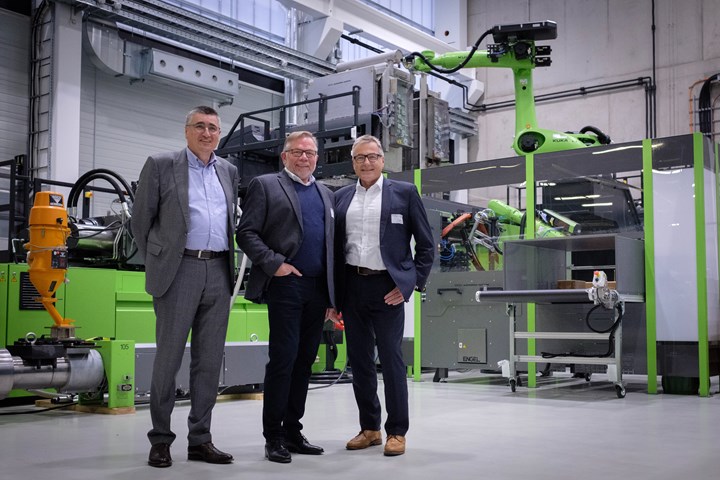Fraunhofer commissions automated Engel production cells for thermoplastic composite R&D
Fraunhofer PAZ pilot plant center installs v-duo 700 vertical machine and duo 900 injection molding machine to combine thermoplastic composite processes with a variety of injection molding technologies.

Left to right: Claus Wilde, managing director of Engel Deutschland, Prof. Peter Michel, head of the polymer applications business unit at the Fraunhofer IMWS and responsible for polymer processing at the Fraunhofer PAZ, and Franz Füreder, vice president, automotive, at Engel Austria. Photo Credit: Engel
Fraunhofer’s Pilot Plant Centre for Polymer Synthesis and Processing PAZ located in Schkopau, Germany, recently commissioned two Engel (Schwertberg, Austria) machines to strengthen its research and development (R&D) of lightweight applications using thermoplastic composites. The two state-of-the-art production cells enable the integration and fully automated production of functional composite components and are now available for customer projects.
“Engel combines a great deal of know-how in lightweight construction with thermoplastic composites and many years of experience in injection molding and the automation of series processes. This is a prerequisite to developing particularly cost-effective series production processes for the automotive and aerospace industries,” says Franz Füreder, vice president, automotive, at Engel. “The two new Engel systems at the Fraunhofer PAZ make it possible to combine thermoplastic-based composite processes with a variety of injection molding technologies, such as foaming or coining.”
From monomer to polymer synthesis and plastics processing on a pilot scale, to the tested series component, Fraunhofer PAZ says it develops new production processes and technologies along the entire value chain of lightweight components. Thermoplastics-based lightweight construction is one development focus, which it shares in common with Engel. “On the one hand, thermoplastic composites enable excellent cost efficiency in series production,” Füreder notes. “On the other, these materials can be returned to the material cycle easily.”
Engel delivered a v-duo 700 vertical machine, which was combined with an Engel easix articulated robot and a large IR oven. An Engel duo 900 injection molding machine with a horizontal clamping unit and two Engel easix robots make up the second commissioned production cell. A vertical IR oven is located above the clamping unit of the latter, enabling fast, hot handling of thermoplastic sheets and blanks made of unidirectional (UD) tapes. Engel has also integrated injection molding technology packages, such as physical foaming.
“Fraunhofer deliberately chose two machines of different types, both of which are widely used in the global automotive industry,” reports Claus Wilde, managing director of Engel Deutschland. “This makes it possible to individually evaluate which machine type and technology enables the most efficient and cost-effective production process for each component.”
Engel and Fraunhofer PAZ are planning to cooperate closely on various development projects in the future. Joint events on the topic of thermoplastic composite lightweight construction at the Fraunhofer PAZ in Schkopau are already in preparation.
Related Content
-
Thermoplastic composites: Cracking the horizontal body panel nut
Versatile sandwich panel technology solves decades-long exterior automotive challenge.
-
PEEK vs. PEKK vs. PAEK and continuous compression molding
Suppliers of thermoplastics and carbon fiber chime in regarding PEEK vs. PEKK, and now PAEK, as well as in-situ consolidation — the supply chain for thermoplastic tape composites continues to evolve.
-
Optimizing a thermoplastic composite helicopter door hinge
9T Labs used Additive Fusion Technology to iterate CFRTP designs, fully exploit continuous fiber printing and outperform stainless steel and black metal designs in failure load and weight.
















